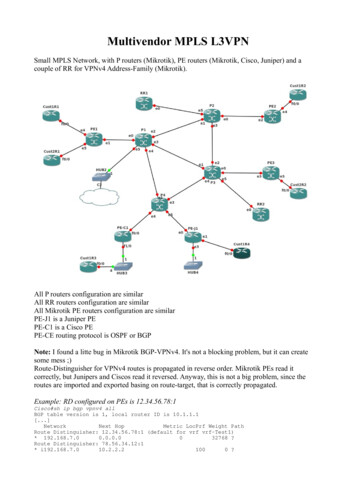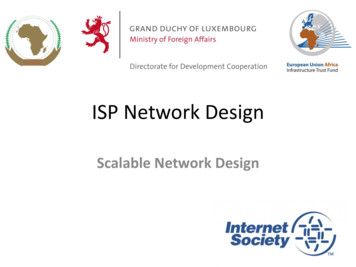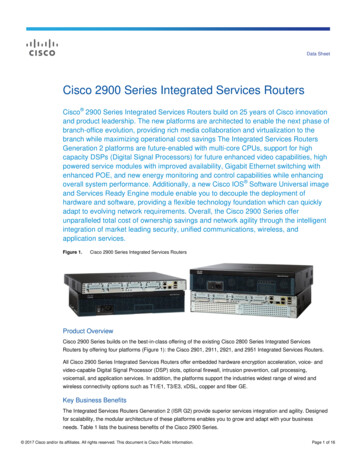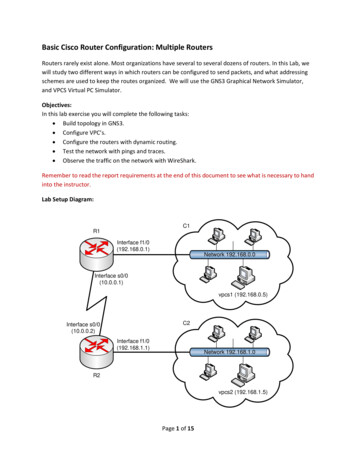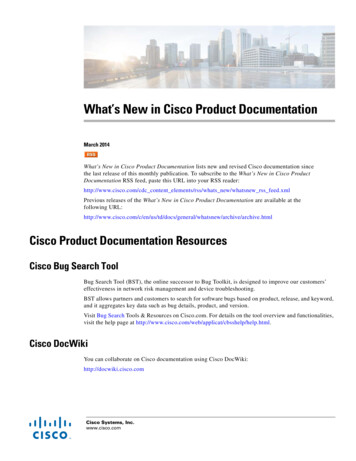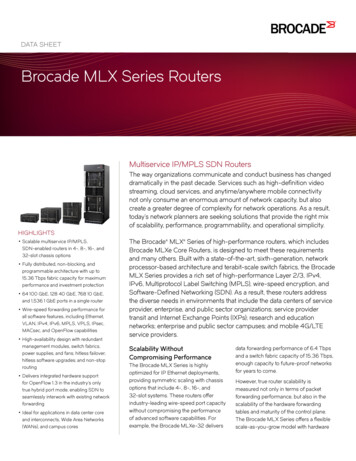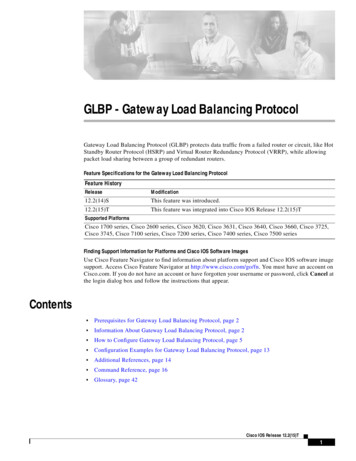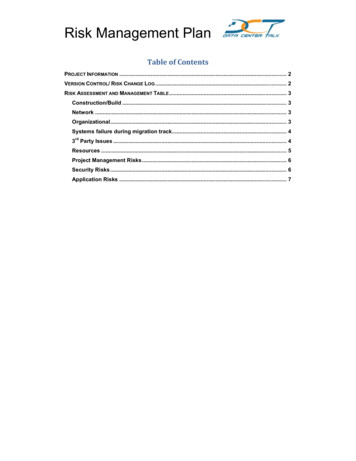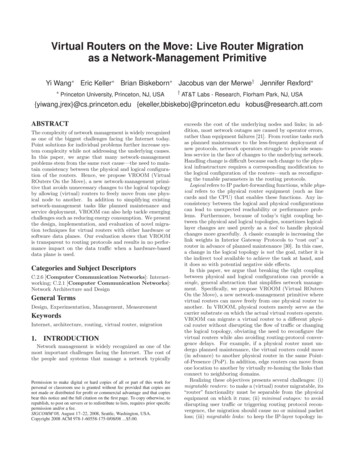
Transcription
Virtual Routers on the Move: Live Router Migrationas a Network-Management PrimitiveYi Wang Eric Keller Brian Biskeborn Jacobus van der Merwe† Jennifer Rexford Princeton University, Princeton, NJ, USA† AT&T Labs - Research, Florham Park, NJ, USA{yiwang,jrex}@cs.princeton.edu {ekeller,bbiskebo}@princeton.edu kobus@research.att.comABSTRACTThe complexity of network management is widely recognizedas one of the biggest challenges facing the Internet today.Point solutions for individual problems further increase system complexity while not addressing the underlying causes.In this paper, we argue that many network-managementproblems stem from the same root cause—the need to maintain consistency between the physical and logical configuration of the routers. Hence, we propose VROOM (VirtualROuters On the Move), a new network-management primitive that avoids unnecessary changes to the logical topologyby allowing (virtual) routers to freely move from one physical node to another. In addition to simplifying existingnetwork-management tasks like planned maintenance andservice deployment, VROOM can also help tackle emergingchallenges such as reducing energy consumption. We presentthe design, implementation, and evaluation of novel migration techniques for virtual routers with either hardware orsoftware data planes. Our evaluation shows that VROOMis transparent to routing protocols and results in no performance impact on the data traffic when a hardware-baseddata plane is used.Categories and Subject DescriptorsC.2.6 [Computer Communication Networks]: Internetworking; C.2.1 [Computer Communication Networks]:Network Architecture and DesignGeneral TermsDesign, Experimentation, Management, MeasurementKeywordsInternet, architecture, routing, virtual router, migration1.INTRODUCTIONNetwork management is widely recognized as one of themost important challenges facing the Internet. The cost ofthe people and systems that manage a network typicallyPermission to make digital or hard copies of all or part of this work forpersonal or classroom use is granted without fee provided that copies arenot made or distributed for profit or commercial advantage and that copiesbear this notice and the full citation on the first page. To copy otherwise, torepublish, to post on servers or to redistribute to lists, requires prior specificpermission and/or a fee.SIGCOMM’08, August 17–22, 2008, Seattle, Washington, USA.Copyright 2008 ACM 978-1-60558-175-0/08/08 . 5.00.exceeds the cost of the underlying nodes and links; in addition, most network outages are caused by operator errors,rather than equipment failures [21]. From routine tasks suchas planned maintenance to the less-frequent deployment ofnew protocols, network operators struggle to provide seamless service in the face of changes to the underlying network.Handling change is difficult because each change to the physical infrastructure requires a corresponding modification tothe logical configuration of the routers—such as reconfiguring the tunable parameters in the routing protocols.Logical refers to IP packet-forwarding functions, while physical refers to the physical router equipment (such as linecards and the CPU) that enables these functions. Any inconsistency between the logical and physical configurationscan lead to unexpected reachability or performance problems. Furthermore, because of today’s tight coupling between the physical and logical topologies, sometimes logicallayer changes are used purely as a tool to handle physicalchanges more gracefully. A classic example is increasing thelink weights in Interior Gateway Protocols to “cost out” arouter in advance of planned maintenance [30]. In this case,a change in the logical topology is not the goal, rather it isthe indirect tool available to achieve the task at hand, andit does so with potential negative side effects.In this paper, we argue that breaking the tight couplingbetween physical and logical configurations can provide asingle, general abstraction that simplifies network management. Specifically, we propose VROOM (Virtual ROutersOn the Move), a new network-management primitive wherevirtual routers can move freely from one physical router toanother. In VROOM, physical routers merely serve as thecarrier substrate on which the actual virtual routers operate.VROOM can migrate a virtual router to a different physical router without disrupting the flow of traffic or changingthe logical topology, obviating the need to reconfigure thevirtual routers while also avoiding routing-protocol convergence delays. For example, if a physical router must undergo planned maintenance, the virtual routers could move(in advance) to another physical router in the same Pointof-Presence (PoP). In addition, edge routers can move fromone location to another by virtually re-homing the links thatconnect to neighboring domains.Realizing these objectives presents several challenges: (i)migratable routers: to make a (virtual) router migratable, its“router” functionality must be separable from the physicalequipment on which it runs; (ii) minimal outages: to avoiddisrupting user traffic or triggering routing protocol reconvergence, the migration should cause no or minimal packetloss; (iii) migratable links: to keep the IP-layer topology in-
Rtact, the links attached to a migrating router must “follow”it to its new location. Fortunately, the third challenge isaddressed by recent advances in transport-layer technologies, as discussed in Section 2. Our goal, then, is to migraterouter functionality from one piece of equipment to anotherwithout disrupting the IP-layer topology or the data trafficit carries, and without requiring router reconfiguration.On the surface, virtual router migration might seem likea straight-forward extention to existing virtual machine migration techniques. This would involve copying the virtualrouter image (including routing-protocol binaries, configuration files and data-plane state) to the new physical routerand freezing the running processes before copying them aswell. The processes and data-plane state would then be restored on the new physical router and associated with themigrated links. However, the delays in completing all ofthese steps would cause unacceptable disruptions for boththe data traffic and the routing protocols. For virtual routermigration to be viable in practice, packet forwarding shouldnot be interrupted, not even temporarily. In contrast, thecontrol plane can tolerate brief disruptions, since routingprotocols have their own retransmission mechansisms. Still,the control plane must restart quickly at the new location toavoid losing protocol adjacencies with other routers and tominimize delay in responding to unplanned network events.In VROOM, we minimize disruption by leveraging theseparation of the control and data planes in modern routers.We introduce a data-plane hypervisor —a migration-awareinterface between the control and data planes. This unifiedinterface allows us to support migration between physicalrouters with different data-plane technologies. VROOM migrates only the control plane, while continuing to forwardtraffic through the old data plane. The control plane canstart running at the new location, and populate the new dataplane while updating the old data plane in parallel. During the transition period, the old router redirects routingprotocol traffic to the new location. Once the data planeis fully populated at the new location, link migration canbegin. The two data planes operate simultaneously for aperiod of time to facilitate asynchronous migration of thelinks.To demonstrate the generality of our data-plane hypervisor, we present two prototype VROOM routers—one witha software data plane (in the Linux kernel) and the otherwith a hardware data plane (using a NetFPGA card [23]).Each virtual router runs the Quagga routing suite [26] in anOpenVZ container [24]. Our software extensions consist ofthree main modules that (i) separate the forwarding tablesfrom the container contexts, (ii) push the forwarding-tableentries generated by Quagga into the separate data plane,and (iii) dynamically bind the virtual interfaces and forwarding tables. Our system supports seamless live migration ofvirtual routers between the two data-plane platforms. Ourexperiments show that virtual router migration causes nopacket loss or delay when the hardware data plane is used,and at most a few seconds of delay in processing controlplane messages.The remainder of the paper is structured as follows. Section 2 presents background on flexible transport networksand an overview of related work. Next, Section 3 discusseshow router migration would simplify existing network management tasks, such as planned maintenance and servicedeployment, while also addressing emerging challenges orkPIrouterP(b)acketawaretransportnetworkFigure 1: Link migration in the transport networkspower management. We present the VROOM architecturein Section 4, followed by the implementation and evaluation in Sections 5 and 6, respectively. We briefly discussour on-going work on migration scheduling in Section 7 andconclude in Section 8.2. BACKGROUNDOne of the fundamental requirements of VROOM is “linkmigration”, i.e., the links of a virtual router should “follow” its migration from one physical node to another. Thisis made possible by emerging transport network technologies. We briefly describe these technologies before giving anoverview of related work.2.1 Flexible Link MigrationIn its most basic form, a link at the IP layer correspondsto a direct physical link (e.g., a cable), making link migration hard as it involves physically moving link end point(s).However, in practice, what appears as a direct link at theIP layer often corresponds to a series of connections throughdifferent network elements at the transport layer. For example, in today’s ISP backbones, “direct” physical links aretypically realized by optical transport networks, where anIP link corresponds to a circuit traversing multiple opticalswitches [9, 34]. Recent advances in programmable transportnetworks [9, 3] allow physical links between routers to bedynamically set up and torn down. For example, as shownin Figure 1(a), the link between physical routers A and Bis switched through a programmable transport network. Bysignaling the transport network, the same physical port onrouter A can be connected to router C after an optical pathswitch-over. Such path switch-over at the transport layercan be done efficiently, e.g., sub-nanosecond optical switching time has been reported [27]. Furthermore, such switching can be performed across a wide-area network of transport switches, which enables inter-POP link migration.
In addition to core links within an ISP, we also want tomigrate access links connecting customer edge (CE) routersand provider edge (PE) routers, where only the PE end ofthe links are under the ISP’s control. Historically, accesslinks correspond to a path in the underlying access network,such as a T1 circuit in a time-division multiplexing (TDM)access network. In such cases, the migration of an access linkcan be accomplished in similar fashion to the mechanismshown in Figure 1(a), by switching to a new circuit at theswitch directly connected to the CE router. However, in traditional circuit-switched access networks, a dedicated physical port on a PE router is required to terminate each TDMcircuit. Therefore, if all ports on a physical PE router are inuse, it will not be able to accommodate more virtual routers.Fortunately, as Ethernet emerges as an economical and flexible alternative to legacy TDM services, access networks areevolving to packet-aware transport networks [2]. This trendoffers important benefits for VROOM by eliminating theneed for per-customer physical ports on PE routers. In apacket-aware access network (e.g., a virtual private LANservice access network), each customer access port is associated with a label, or a “pseudo wire” [6], which allows a PErouter to support multiple logical access links on the samephysical port. The migration of a pseudo-wire access linkinvolves establishing a new pseudo wire and switching to itat the multi-service switch [2] adjacent to the CE.Unlike conventional ISP networks, some networks are realized as overlays on top of other ISPs’ networks. Examplesinclude commercial “Carrier Supporting Carrier (CSC)” networks [10], and VINI, a research virtual network infrastructure overlaid on top of National Lambda Rail and Internet2 [32]. In such cases, a single-hop link in the overlaynetwork is actually a multi-hop path in the underlying network, which can be an MPLS VPN (e.g., CSC) or an IPnetwork (e.g., VINI). Link migration in an MPLS transportnetwork involves switching over to a newly established labelswitched path (LSP). Link migration in an IP network canbe done by changing the IP address of the tunnel end point.2.2 Related WorkVROOM’s motivation is similar, in part, to that of theRouterFarm work [3], namely, to reduce the impact of plannedmaintenance by migrating router functionality from one placein the network to another. However, RouterFarm essentially performs a “cold restart”, compared to VROOM’s live(“hot”) migration. Specifically, in RouterFarm router migration is realized by re-instantiating a router instance at thenew location, which not only requires router reconfiguration,but also introduces inevitable downtime in both the controland data planes. In VROOM, on the other hand, we performlive router migration without reconfiguration or discernibledisruption. In our earlier prototype of VROOM [33], routermigration was realized by directly using the standard virtualmachine migration capability provided by Xen [4], whichlacked the control and data plane separation presented inthis paper. As a result, it involved data-plane downtimeduring the migration process.Recent advances in virtual machine technologies and theirlive migration capabilities [12, 24] have been leveraged inserver-management tools, primarily in data centers. For example, Sandpiper [35] automatically migrates virtual serversacross a pool of physical servers to alleviate hotspots. Usher [22]allows administrators to express a variety of policies formanaging clusters of virtual servers. Remus [13] uses asynchronous virtual machine replication to provide high availability to server in the face of hardware failures. In contrast,VROOM focuses on leveraging live migration techniques tosimplify management in the networking domain.Network virtualization has been proposed in various contexts. Early work includes the “switchlets” concept, in whichATM switches are partitioned to enable dynamic creationof virtual networks [31]. More recently, the CABO architecture proposes to use virtualization as a means to enablemultiple service providers to share the same physical infrastructure [16]. Outside the research community, router virtualization has already become available in several forms incommercial routers [11, 20]. In VROOM, we take an additional step not only to virtualize the router functionality,but also to decouple the virtualized router from its physicalhost and enable it to migrate.VROOM also relates to recent work on minimizing transient routing disruptions during planned maintenance. Ameasurement study of a large ISP showed that more thanhalf of routing changes were planned in advance [19]. Network operators can limit the disruption by reconfiguring therouting protocols to direct traffic away from the equipmentundergoing maintenance [30, 17]. In addition, extensionsto the routing protocols can allow a router to continue forwarding packets in the data plane while reinstalling or rebooting the control-plane software [29, 8]. However, thesetechniques require changes to the logical configuration or therouting software, respectively. In contrast, VROOM hidesthe effects of physical topology changes in the first place,obviating the need for point solutions that increase systemcomplexity while enabling new network-management capabilities, as discussed in the next section.3. NETWORK MANAGEMENT TASKSIn this section, we present three case studies of the applications of VROOM. We show that the separation between physical and logical, and the router migration capability enabled by VROOM, can greatly simplify existingnetwork-management tasks. It can also provide networkmanagement solutions to other emerging challenges. We explain why the existing solutions (in the first two examples)are not satisfactory and outline the VROOM approach toaddressing the same problems.3.1 Planned MaintenancePlanned maintenance is a hidden fact of life in every network. However, the state-of-the-art practices are still unsatisfactory. For example, software upgrades today still requirerebooting the router and re-synchronizing routing protocolstates from neighbors (e.g., BGP routes), which can leadto outages of 10-15 minutes [3]. Different solutions havebeen proposed to reduce the impact of planned maintenanceon network traffic, such as “costing out” the equipment inadvance. Another example is the RouterFarm approach ofremoving the static binding between customers and accessrouters to reduce service disruption time while performingmaintenance on access routers [3]. However, we argue thatneither solution is satisfactory, since maintenance of physicalrouters still requires changes to the logical network topology,and requires (often human interactive) reconfigurations androuting protocol reconvergence. This usually implies moreconfiguration errors [21] and increased network instability.
We performed an analysis of planned-maintenance eventsconducted in a Tier-1 ISP backbone over a one-week period.Due to space limitations, we only mention the high-levelresults that are pertinent to VROOM here. Our analysisindicates that, among all the planned-maintenance eventsthat have undesirable network impact today (e.g., routingprotocol reconvergence or data-plane disruption), 70% couldbe conducted without any network impact if VROOM wereused. (This number assumes migration between routerswith control planes of like kind. With more sophisticatedmigration strategies, e.g., where a “control-plane hypervisor” allows migration between routers with different control plane implementations, the number increases to 90%.)These promising numbers result from the fact that mostplanned-maintenance events were hardware related and, assuch, did not intend to make any longer-term changes to thelogical-layer configurations.To perform planned maintenance tasks in a VROOMenabled network, network administrators can simply migrateall the virtual routers running on a physical router to otherphysical routers before doing maintenance and migrate themback afterwards as needed, without ever needing to reconfigure any routing protocols or worry about traffic disruptionor protocol reconvergence.3.2 Service Deployment and EvolutionDeploying new services, like IPv6 or IPTV, is the lifeblood of any ISP. Yet, ISPs must exercise caution when deploying these new services. First, they must ensure thatthe new services do not adversely impact existing services.Second, the necessary support systems need to be in placebefore services can be properly supported. (Support systems include configuration management, service monitoring,provisioning, and billing.) Hence, ISPs usually start with asmall trial running in a controlled environment on dedicatedequipment, supporting a few early-adopter customers. However, this leads to a “success disaster” when the service warrants wider deployment. The ISP wants to offer seamlessservice to its existing customers, and yet also restructuretheir test network, or move the service onto a larger network to serve a larger set of customers. This “trial systemsuccess” dilemma is hard to resolve if the logical notion of a“network node” remains bound to a specific physical router.VROOM provides a simple solution by enabling networkoperators to freely migrate virtual routers from the trialsystem to the operational backbone. Rather than shuttingdown the trial service, the ISP can continue supporting theearly-adopter customers while continuously growing the trialsystem, attracting new customers, and eventually seamlesslymigrating the entire service to the operational network.ISPs usually deploy such service-oriented routers as closeto their customers as possible, in order to avoid backhaultraffic. However, as the services grow, the geographical distribution of customers may change over time. With VROOM,ISPs can easily reallocate the routers to adapt to new customer demands.TWh (Tera-Watt hours) [28]. This number was expectedto grow to 1.9 to 2.4TWh in the year 2005 by three different projection models [28], which translates into an annualcost of about 178-225 million dollars [25]. These numbers donot include the power consumption of the required coolingsystems.Although designing energy-efficient equipment is clearlyan important part of the solution [18], we believe that network operators can also manage a network in a more powerefficient manner. Previous studies have reported that Internet traffic has a consistent diurnal pattern caused by humaninteractive network activities. However, today’s routers aresurprisingly power-insensitive to the traffic loads they arehandling—an idle router consumes over 90% of the powerit requires when working at maximum capacity [7]. We argue that, with VROOM, the variations in daily traffic volume can be exploited to reduce power consumption. Specifically, the size of the physical network can be expanded andshrunk according to traffic demand, by hibernating or powering down the routers that are not needed. The best wayto do this today would be to use the “cost-out/cost-in” approach, which inevitably introduces configuration overheadand performance disruptions due to protocol reconvergence.VROOM provides a cleaner solution: as the network traffic volume decreases at night, virtual routers can be migrated to a smaller set of physical routers and the unneededphysical routers can be shut down or put into hibernationto save power. When the traffic starts to increase, physical routers can be brought up again and virtual routerscan be migrated back accordingly. With VROOM, the IPlayer topology stays intact during the migrations, so thatpower savings do not come at the price of user traffic disruption, reconfiguration overhead or protocol reconvergence.Our analysis of data traffic volumes in a Tier-1 ISP backbone suggests that, even if only migrating virtual routerswithin the same POP while keeping the same link utilization rate, applying the above VROOM power managementapproach could save 18%-25% of the power required to runthe routers in the network. As discussed in Section 7, allowing migration across different POPs could result in moresubstantial power savings.4. VROOM ARCHITECTUREIn this section, we present the VROOM architecture. Wefirst describe the three building-blocks that make virtualrouter migration possible—router virtualization, control anddata plane separation, and dynamic interface binding. Wethen present the VROOM router migration process. Unlike regular servers, modern routers typically have physicallyseparate control and data planes. Leveraging this uniqueproperty, we introduce a data-plane hypervisor between thecontrol and data planes that enables virtual routers to migrate across different data-plane platforms. We describe indetail the three migration techniques that minimize controlplane downtime and eliminate data-plane disruption—dataplane cloning, remote control plane, and double data planes.3.3 Power Savings4.1 Making Virtual Routers MigratableVROOM not only provides simple solutions to conventional network-management tasks, but also enables new solutions to emerging challenges such as power management.It was reported that in 2000 the total power consumption ofthe estimated 3.26 million routers in the U.S. was about 1.1Figure 2 shows the architecture of a VROOM router thatsupports virtual router migration. It has three importantfeatures that make migration possible: router virtualization,control and data plane separation, and dynamic interfacebinding, all of which already exist in some form in today’s
nbclhredoanotaupsllianneksmdigurartiin0 it1VduBPeo1PrRAAndredirectiontunnels)(t4 t5)(t5 gmessaget6)s))redictionofroutingmessagesFigure 3: VROOM’s novel router migration mechanisms (the times at the bottom of the subfigures correspondto those in Figure intnteerrfafacceeFigure 2: The architecture of a VROOM routerhigh-end commercial routers.Router Virtualization: A VROOM router partitions theresources of a physical router to support multiple virtualrouter instances. Each virtual router runs independentlywith its own control plane (e.g., applications, configurations, routing protocol instances and routing informationbase (RIB)) and data plane (e.g., interfaces and forwardinginformation base (FIB)). Such router virtualization supportis already available in some commercial routers [11, 20]. Theisolation between virtual routers makes it possible to migrateone virtual router without affecting the others.Control and Data Plane Separation: In a VROOMrouter, the control and data planes run in separate environments. As shown in Figure 2, the control planes of virtualrouters are hosted in separate “containers” (or “virtual environments”), while their data planes reside in the substrate,where each data plane is kept in separate data structureswith its own state information, such as FIB entries and access control lists (ACLs). Similar separation of control anddata planes already exists in today’s commercial routers,with control plane running on the CPU(s) and main memory,while the data plane runs on line cards that have their owncomputing power (for packet forwarding) and memory (tohold the FIBs). This separation allows VROOM to migratethe control and data planes of a virtual router separately (asdiscussed in Section 4.2.1 and 4.2.2).Dynamic Interface Binding: To enable router migrationFigure 4: VROOM’s router migration processand link migration, a VROOM router should be able to dynamically set up and change the binding between a virtualrouter’s FIB and its substrate interfaces (which can be physical or tunnel interfaces), as shown in Figure 2. Given theexisting interface binding mechanism in today’s routers thatmaps interfaces with virtual routers, VROOM only requirestwo simple extensions. First, after a virtual router is migrated, this binding needs to be re-established dynamicallyon the new physical router. This is essentially the same asif this virtual router were just instantiated on the physicalrouter. Second, link migration in a packet-aware transportnetwork involves changing tunnel interfaces in the router, asshown in Figure 1. In this case, the router substrate needsto switch the binding from the old tunnel interface to thenew one on-the-fly1 .4.2 Virtual Router Migration ProcessFigures 3 and 4 illustrate the VROOM virtual router migration process. The first step in the process involves establishing tunnels between the source physical router A anddestination physical router B of the migration (Figure 3(a)).These tunnels allow the control plane to send and receiverouting messages after it is migrated (steps 2 and 3) but before link migration (step 5) completes. They also allow themigrated control plane to keep its data plane on A up-to1In the case of a programmable transport network, link migration happens inside the transport network and is transparent to the routers.
date (Figure 3(b)). Although the control plane will experience a short period of downtime at the end of step 3 (memorycopy), the data plane continues working during the entiremigration process. In fact, after step 4 (data-plane cloning),the data planes on both A and B can forward traffic simultaneously (Figure 3(c)). With these double data planes,links can be migrated from A to B in an asynchronous fashion (Figure 3(c) and (d)), after which the data plane on Acan be disabled (Figure 4). We now describe the migrationmechanisms in greater detail.4.2.1 Control-Plane MigrationTwo things need to be taken care of when migrating thecontrol plane: the router image, such as routing-protocolbinaries and network configuration files, and the memory,which includes the states of all the running processes. Whencopying the router image and memory, it is desirable to minimize the total migration time, and more importantly, tominimize the control-plane downtime (i.e., the time betweenwhen the control plane is check-pointed on the source nodeand when it is restored on the destination node). This is because, although routing protocols can usually tolerate a briefnetwork glitch using retransmission (e.g., BGP uses TCPretransmission, while OSPF uses its own reliable retransmission mechanism), a long control-plane outage can breakprotocol adjacencies and cause protocols to reconverge.We now describe how VROOM leverages virtual machine(VM) migration techniques to migrate the con
Virtual Routers on the Move: Live Router Migration as a Network-Management Primitive Yi Wang Eric Keller Brian Biskeborn Jacobus van der Merwe† Jennifer Rexford Princeton University, Princeton, NJ, USA † AT&T Labs - Research, Florham Park, NJ, USA {yiwang,jrex}@cs.princeton.edu {ekeller,bbiskebo}@princeton.edu kobus@research.att.com


